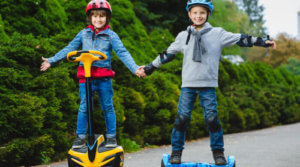Bright colors. Different shapes. Different materials and utensils. Every child can paint – no matter how old they are. That’s why we have compiled 11 ideas for painting for children at different ages for you.
Painting and creative work is important for the development of your child. Both train his motor skills and creativity. In addition, it strengthens the self-confidence of your treasure when he has created a great work of art all by himself.
Table of contents
When Do Children Start Learning To Paint?
Most children start painting at the age of 12 to 13 months Months. Even your baby can already be creative in one way or another in one way or another. He reaches for pens and scribbles his first lines on paper.
Your child begins to paint intuitively and is fascinated by the traces fascinated by the traces that the pencil leaves on the paper.
When painting for children, it is important that you make the experience age-appropriate. After all, you don’t want to overtax your child, by making demands on them that they can’t yet meet.
As your child grows older, he or she will learn to become more aware of his or and understands how it can also represent this creatively.
Painting strengthens the cognitive and motor skills of your child and Your child’s cognitive and motor skills are strengthened and his imagination continues to develop.
Painting For Children – Babies And Toddlers
Your very small treasure can of course not yet hold a pencil or brushes. But glide with their hands over papers or canvases and scribble and scribble and smear he can certainly. At this age, babies are in the the smudging phase and carefully follow the traces that their hands leave on the On the surface.
Finger Paints On Canvas
Finger paints are ideal for very young artists Artists. It can be a great creative experience for the whole family to wildly with colors on a canvas or paper.
If that’s what you prefer, there are definitely one or two other clean alternative when painting for children. Distribute dots of paint on a canvas and a canvas and then cover it with cling film. This way your baby can can smear the paint without having it on their body.
Stamping
Small children take great pleasure in stamping. For this you can use, for example, small balloons or cups. Your little Artist can grasp them well, because their fine motor skills are not yet quite as must be not quite so far developed.
Of course, you can also make great prints with your hands and feet Create great impressions. This is especially fun with the whole family when everyone leaves colorful prints on a canvas with their hands and feet.
Isn’t it a great way to capture the first creative Of the own child thereby and to hold the collected imprints even as a family painting to hang on the wall as a memento?
Painting For Children – Toddlers From 1 Year Of Age
At about one year of age, your child learns to grab things purposefully grasp. These are important first exercises, in order to be able to lead later times a pin purposefully over the paper. During this time, your child learns the The connection between the pen and the movement of his hand over the paper understand.
Scribbling
In the second year of life, children begin to doodle. Therefore this phase is also described as the scribbling phase. Large crayons such as thick Crayons or special colored pencils are the best thing for children to use during this Best for children to draw with, because they train the grip, but at the same time are easy to hold in the hand to hold.
Painting With Vehicles
It will be a special fun if you use toy cars as brushes with your child and use them for painting as paintbrushes and use them for painting. Simply dip the wheels of the car of the car in a color and roll them over the paper. This creates colorful Works of art from colored lines, curves and various shapes.
Painting For Children Of Kindergarten Age
At around 3 years of age, children begin to make their first drawings that reveal individual motifs. Suns or the cephalopod, a kind of stick figure, are popular first picture contents.
You can give your child a special treat if you now provide him or her with other utensils such as crayons, watercolors, chalk and felt-tip Crayons, watercolors, chalk and felt-tip pens and expand the repertoire.
From the age of 4 years, slowly more details come into your child’s in your child’s pictures. This phase is called the pre-schema phase. At this Age, almost all children have learned how to hold the pencil correctly and can and can move it safely across the paper.
You can now recognize yourself more and more often on your child’s recognize yourself more and more often. In addition, the dad is painted. Also the apartment, the house or the garden with its colorful flowers are put on paper and proudly presented proudly presented as finished drawings.
Painting On Canvas
On large sheets of paper and canvases can your child can let off steam and try out new things. He or she is old enough to use a brush and Paintbox and create creative works of art. Together you can discover new colors by mixing them and your child learns with your help How many colors there can be when they are combined with each other combined with each other.
Coloring Books
From about the age of 3, you can get your child excited about for coloring templates.
Coloring books are good training for fine motor skills, Creativity and analytical skills when coloring for children. Depending on the age they have different complexity. They are available on different themes.
Your child can to his heart’s content the various motifs with the colors of his choice. Perhaps his ambition will be awakened to cleanly paint the individual shapes, perhaps it is first also just to paint wildly.
If your sweetheart shows no interest at all, do you no further thoughts. It always depends a bit on the skill and Interest of your child. Your child may just need a little longer. Every Child has his or her own pace.
Chalk
Chalk is easy to hold and is an exciting way for children to Way for children to expand their repertoire of painting tools expand. Painting with chalk on the street is a very special adventure for your child, because life-size Adventure for your child, because life-size works of art are created and there is no paper and no canvas to limit the picture.
Especially exciting: After the next rain, the picture disappears and a new Picture disappears and a new work of art can be created.
Painting For Preschool Children
At this age, children develop a sense that painted objects are related to each other. In addition, the colorful Design becomes more and more interesting for your treasure.
Painting By Numbers
Similar to the coloring books, painting by numbers involves coloring in finished templates are colored. The individual areas to be colored are provided with small numbers. Areas with the same numbers are painted in the same color. Depending on the age of the children, the complex and the fields to be colored smaller and smaller.
Your child learns which colors belong to which motif and develops and develops a feeling for colors and shapes.
Combination Of Different Techniques
It is especially exciting for your child to use different utensils and Utensils and drawing techniques. It is a lot of fun to create shapes that can later be colored with watercolor, for example:
Your child can draw circles on a surface with a cup and a pencil on a surface. Lots of them, so that a pattern of many circles is created, that overlap each other. Watercolors can then be used to color in the individual small squares and Shapes can be painted.
In the connection of different painting techniques are you and And your child are no limits and there are countless Possible combinations. Just let yourself be inspired by the things that you can can find at home.
Painting For Children – School Children
If your child comes to school, then the creative projects may be a little more complex. School requires a variety of fine motor skills that your child will learn to master.
Do you like to be creative yourself and want to design your child’s school cone yourself? We show you how!
Adding Pictures
At school age, your child has already learned to cut out shapes and elements Elements. If he or she doesn’t really know what to draw, then it is a great idea to complete a picture.
Your child cuts out a motif of his or her choice from a newspaper or a photo and glue it on. Then they can be creative to their heart’s content and paint a picture around this snippet.
By adding to this original picture, the child does not need to have for a picture, but rather has a helping hand.
Especially exciting: Cut a photo of your child in half In the middle. This way they can paint their first self-portrait without looking in the mirror to look in the mirror and to be able to draw everything directly alone.
Luminous Chalk
Of course your child has been able to draw with chalk for some time, to draw with chalk. Now comes a special incentive. During the day it paints a picture with chalk on the street. In the evening, when it gets dark, the artwork suddenly Work of art suddenly begins to glow. Your sweetheart will be amazed.
What You Should Pay Attention To When Painting For Children
Basically, your child should be allowed to paint what it wants to paint would like to paint. It is important that you do not interfere with your child’s creative process when he or she is when he or she is absorbed and content.
But there are also phases in which your child wants and needs support support and also needs it. Then, of course, you should give him the help he needs give him the help he needs so he doesn’t lose fun and get frustrated.
Watch out: Small children do not yet know any limits and don’t know what they can and can’t paint on. Therefore, you should be Paint and, if possible, cover up things that should not get paint on them should get.
Otherwise, you will quickly have a newly designed wallpaper in the Living room or a colorful pattern on the tablecloth.
Motivate Your Child To Paint
If you want to encourage your child to paint, it is a good idea to give him to provide him with as many different utensils as possible. However, these should be age-appropriate.
Don’t be surprised if your child doesn’t really know what to do with the not really know what to do with the pens, brushes and colors. Not every child likes to paint. After all, we all have our own interests and Preferences.
No matter what age, your child will be very proud of his or her Works of art. After completion, your treasure will want to present you his work will of course want to present his work to you. Show your child that he or she has every right to be proud to be proud. Serious praise is the best motivation to continue directly to continue. And after all, practice makes perfect.
Even if your treasure’s works of art never become real masterpieces masterpieces, that’s not what matters. After all, what matters is having fun and enjoying painting, not perfection.
These 11 tips should give you some guidance on what age-appropriate creative projects are when painting for kids. Of course, free painting is always great and you don’t necessarily need more than pen and paper for your child. These tips are inspiration if your child needs some encouragement or wants to try something new.
Do you want to get creative with your child in a different way? Maybe crafting with papier-mâché or a pinata would be right for you.
FAQ About Painting For Kids
Sources
Vopel, K. W. (2011). Art therapy for children: 100 ideas for drawing and painting. Iskopress, Salzhausen.
Peez, G. (2015). Children drawing, painting and designing. Art and visual-aesthetic practice in the KiTa. Kohlhammer, Stuttgart.










